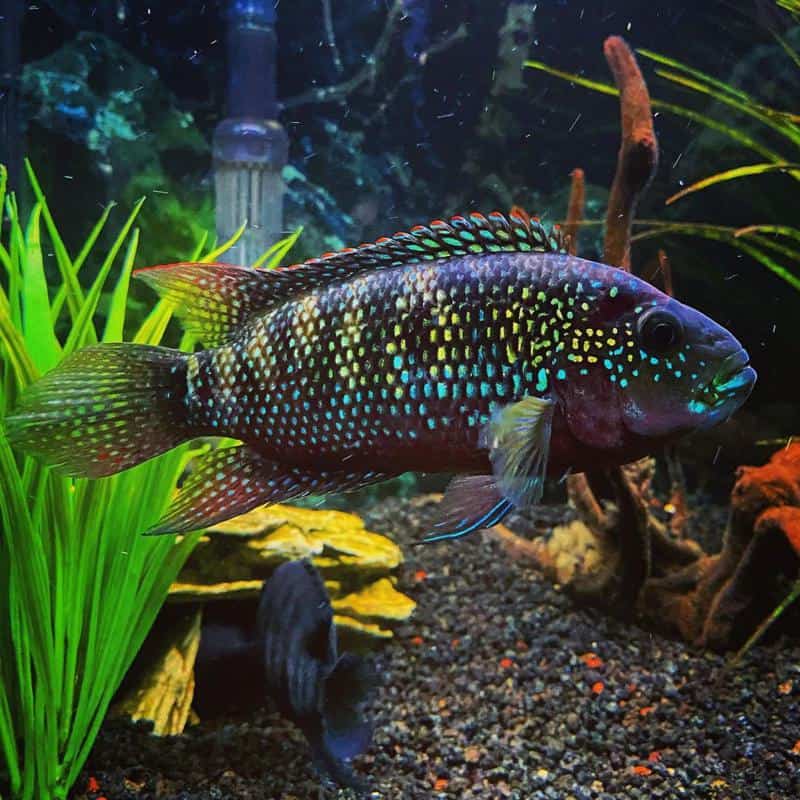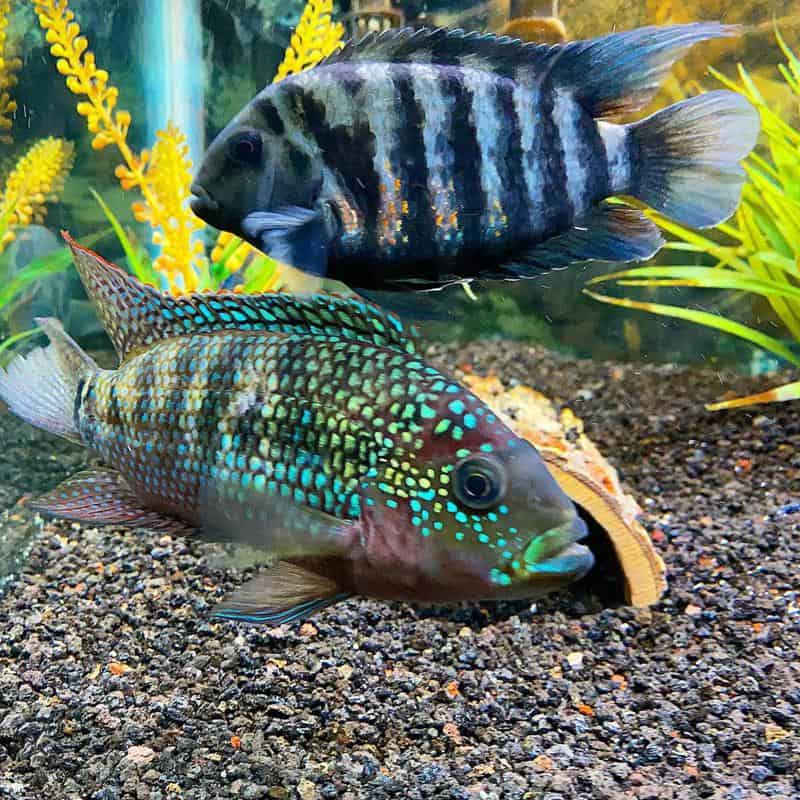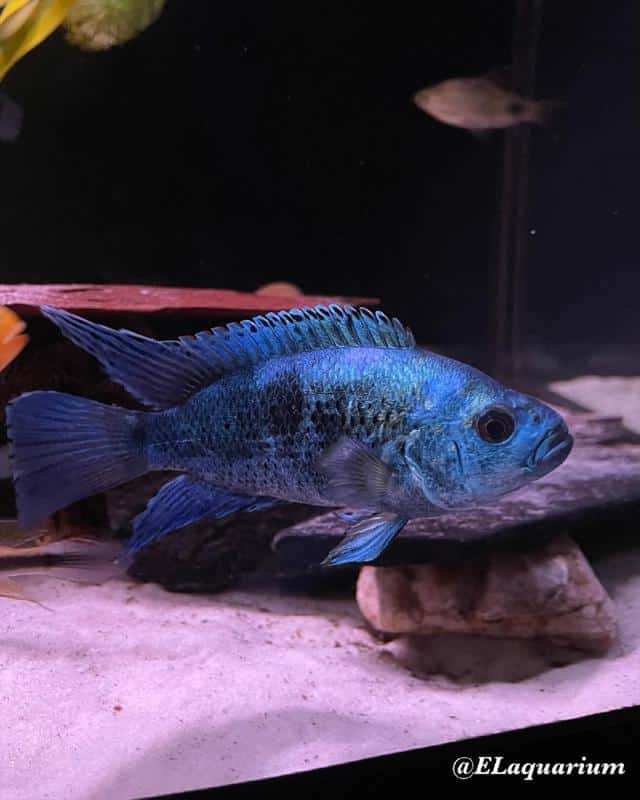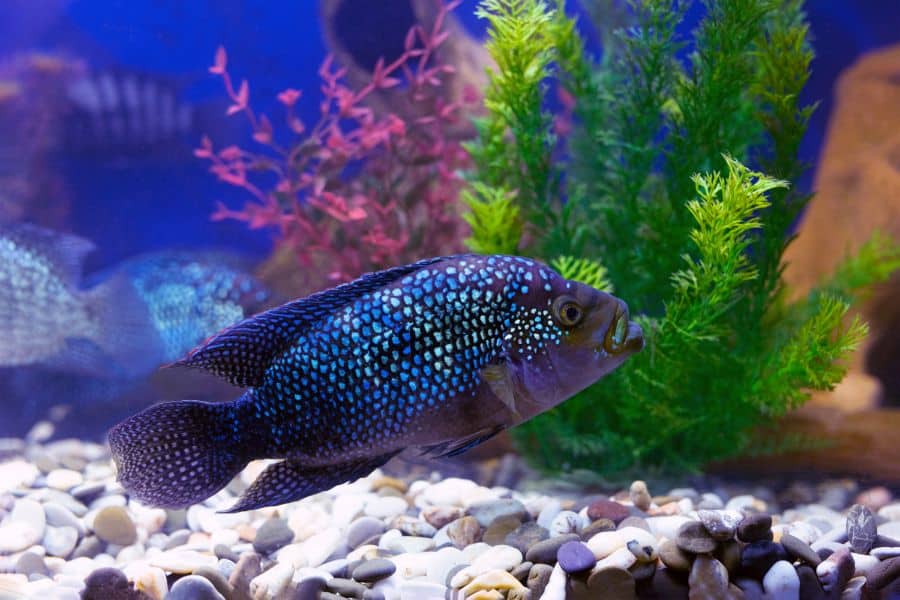The Electric Blue Jack Dempsey is one of the most popularly owned cichlid species, no doubt due to its dazzling appearance. This fish is sure to be the star of any freshwater aquarium with its striking bright-blue scales and bold character.
But if looks weren’t enough, the Electric Blue Jack Dempsey is also a firecracker in the personality department. Its confidence and ability to recognize its owners makes it equally as fun to interact with!
If you’re thinking of owning this eclectic cichlid species, our Electric Blue Jack Dempsey care guide will go over everything you need to know, from diet to breeding.
Electric Blue Jack Dempsey Overview
| Scientific Name | Rocio octofasciata |
| Origin | Southern Mexico, Belize, Guatemala, & Honduras in slow-moving waters |
| Size | Up to 8 inches |
| Color | Powder blue |
| Diet | Omnivore |
| Temperament | Semi-aggressive |
| Tank Size | 55 gallons |
| Ideal Tank Mates | Large, semi-aggressive or bottom-dwelling fish |
| Water Parameters | 6-7 pH, 73-78°F, and 9-10 dGH |
| Lifespan | 10-15 years |
| Breeding | Egg-laying |
The Electric Blue Jack Dempsey is a rare mutation of the standard Jack Dempsey, which is a South American species of cichlid.
The variant is believed to have been first seen in captive-bred Jack Dempseys in Asia, but it can also occur naturally in the wild. Wild specimens originate from Southern Mexico, Belize, Guatemala, and Honduras.
You’ll find them in slow-moving tropical waters like rivers, wetlands, and swamps. They prefer stagnant water with ample mud and sand where they can burrow.
You might be familiar with the name “Jack Dempsey” if you’re a boxing fan. It comes from the famous boxer of the same moniker, who was well-recognized for his aggression in the ring. These fish are equally as fearsome, which is why they share the same name!
Electric Blue Jack Dempsey Appearance

The Electric Blue Jack Dempsey is easily recognized by its vivid blue coloration, which you might have already guessed by the species name. The body of this fish is covered in flecks of metallic blue with dark stripes that span the length of the back and sides.
Juveniles are much paler than their adult counterparts with less vibrant blue scales and white or tan bodies.
Related: Electric Blue Ram
How to Sex an Electric Blue Jack Dempsey
Both male and female Electric Blue Jack Dempseys are brightly colored, so it can be a little difficult to sex them at first glance. The species also doesn’t show much sexual dimorphism until breeding age (roughly 4 inches in size).
However, males are typically larger than females with pointed anal and dorsal fins. Females are rounder around the abdominal region and are usually less aggressive.
How Big Does an Electric Blue Jack Dempsey Get?
Compared to natural variants of this cichlid species, the Electric Blue Jack Dempsey is slightly smaller, though it isn’t a small fish by any means! Most specimens reach around 8 inches in length, with males being a little bigger than females.
Standard Jack Dempseys, on the other hand, can grow to approximately 10 to 12 inches in size.
Bear in mind that the majority of Electric Blue Jack Dempseys sold at pet stores are juveniles, so they will be considerably smaller when you first purchase them.
How Long Does an Electric Jack Dempsey Live For?
The Electric Jack Dempsey is a relatively long-lived species that can reach between 10 to 15 years of care. Like with any fish, good husbandry is paramount for keeping your Electric Blue Jack Dempsey happy and healthy.
Regular water changes, a varied diet, and the right setup can all help promote great health and a long life.
How to Care for the Electric Blue Jack Dempsey
In addition to their stunning appearance, Electric Blue Jack Dempseys are relatively straightforward to care for. They can be a bit more sensitive to water quality and parameters than standard Jack Dempseys, but this shouldn’t be an issue as long as you practice good aquarium maintenance.
If kept alone without tank mates, the Electric Blue Jack Dempsey is a great beginner-friendly fish. However, as a cichlid species, they can be quite aggressive with other fish, which can be challenging to deal with for new fishkeepers.
Only experienced aquarists should consider keeping this species in a community setup.
Behavior & Temperament
Like other cichlids, Electric Blue Jack Dempseys are energetic and inquisitive fish that can be the real star of an aquarium.
Although they’re mostly known for their aggressive tendencies, especially during breeding, there’s a lot more to this fish than its fierceness!
For instance, this species loves to dig and burrow in the substrate. They’ll even rearrange the tank decor on a regular basis, particularly after a water change.
Electric Blue Jack Dempseys also enjoy exploring their environment, hunting for food (they’re fascinating to watch if you feed them live foods!), and interacting with their owners.
What Tank Size Does an Electric Blue Jack Dempsey Need?
Due to their active nature, the Electric Blue Jack Dempsey needs a fairly large aquarium to explore. A 55-gallon tank is the bare minimum for a single adult.
If you plan on keeping your Electric Blue Jack Dempsey in a community tank, you’ll need a much larger aquarium to spread out aggression.
Jack Dempseys can be territorial with their own kind and other fish, even more so in small tanks.
How Many Electric Blue Jack Dempseys Should I Keep?
Electric Blue Jack Dempseys are quite territorial with their own species, so it’s best to keep them alone or in breeding pairs. Males should not be kept with other males as they will fight.
While you can keep this species in small groups, you’ll need a very large aquarium to do so. It’s recommended to keep just one male to a group of females or all females.
Unfortunately, even in big tanks, aggression can still arise, so it’s always a good idea to have a backup tank in case you need to separate particularly hostile individuals.
Ideal Tank Mates

Despite their aggressive nature, the Electric Blue Jack Dempsey can coexist with other fish provided you select the right tank mates. You should opt for large, boisterous fish species as small fish and invertebrates are likely to be preyed on or an easy target for bullying.
Other cichlids like Oscars, convict cichlids, and firemouth cichlids can be good choices. However, it’s crucial that you have a big enough aquarium for each species to explore and set up their own territories.
Big, shoaling fish like silver collars can also work, as can large bottom-dwelling species like the common pleco and hoplo catfish.
Water Parameters
Compared to standard Jack Dempsey cichlids, the Electric Blue variant can be more sensitive to water parameters. It’s important to provide your fish with the right aquatic environment to keep them in tip-top shape.
As these fish are a tropical species, they require warm water heated to approximately 73 to 78°F. Water hardness for these fish should be between 9 to 10 dGH as they prefer hard water, and pH should be around 6 to 7.
Electric Blue Jack Dempsey Diet
As omnivores, Electric Blue Dempseys require both meaty foods and plant matter in their diet. You’ll need to offer them a variety of food sources to keep them in good shape and health.
High-quality flakes or pellets should be the staple of your fish’s diet, but you can also give them frozen or live foods like brine shrimp, bloodworms, and mosquito larvae.
Be sure to offer some vegetables like zucchini, peas, and cucumber every now and again to make up the plant component of their diet, too!
How Often Should I Feed My Electric Blue Jack Dempsey?
It’s best to feed your Electric Blue Dempsey twice daily, ideally waiting several hours between each feeding to prevent bloating (once in the morning and once in the early evening is a good schedule).
Make sure you only offer your fish as much food as they can eat within two to three minutes. Remove any uneaten food after this time so you don’t pollute your tank water.
Electric Blue Jack Dempsey Breeding

Breeding the Electric Blue Jack Dempsey cichlid is a fairly time-consuming process as it requires a bit more work to obtain fry that possess the electric blue trait. You see, a male/female pair of Electric Blue Jack Dempseys cannot produce healthy fry (they almost always die early into their development).
The most effective way to breed this species is by crossbreeding an Electric Blue variant with a standard Jack Dempsey cichlid. This will result in some Electric Blue fry, though most will be normal colored. However, all of them will carry the blue gene.
These blue-gene fish can then be bred with Electric Blue Jack Dempseys, which will yield around 50% with the electric-blue color (the other half will be wild form). Although it’s a long-winded process, you’ll end up with much healthier and stronger fry using this method.
How to Breed Electric Blue Jack Dempseys (Step-by-Step)
A bonded pair of Jack Dempseys will normally spawn on a regular basis provided they are given a spacious tank with the ideal water parameters. However, there are some things you can do to encourage the process, which we’ll go over below!
Step 1
If your Jack Dempsey cichlids are in a community tank, move them to a separate breeding tank (a 20-gallon or larger). This species is notoriously aggressive during spawning, so you should avoid having other fish around.
Step 2
Feed the male/female pair protein-rich foods like live bloodworms and brine shrimp as this will prepare them for breeding.
Step 3
Make sure your tank has a soft substrate like sand and has plenty of flat rocks, caves, and vegetation. Jack Dempsey cichlids prefer to lay their eggs on the substrate or a flat surface.
Step 4
If the pair are interested in mating, they will begin to dig out a hole in the substrate or clean a flat rock with their mouths. Once the desired area is prepared, the female will lay up to 500 eggs and the male will fertilize them.
Step 5
Male and female Jack Dempsey cichlids are excellent parents and will take turns caring for the eggs. Both fish will guard the eggs and fan them with their fins (doing so aerates the eggs and prevents fungus).
Step 6
It usually takes around 3 days for the eggs to hatch, but you don’t need to remove the parents until they are free-swimming as they will continue to attend to their offspring.
The fry will consume their egg sacs for a few days, but you’ll need to feed them baby brine shrimp or infusoria after this.
Step 7
It normally takes around 10 days for the fry to reach the free-swimming stage, so make sure you move the parents to another tank at this point as they will likely eat the babies.
Step 8
Continue to feed the fry baby brine shrimp/infusoria. Once they are around a month old, you can move them to a larger grow-out tank.
Read More:
Final Thoughts
With its beauty and charm, it’s not difficult to see why the Electric Blue Jack Dempsey has captured so many fishkeepers’ hearts. Although a little harder to keep than the standard version, Electric Blue Jack Dempseys are well worth the extra maintenance and care.
Make sure you have at least a 55-gallon tank for a single adult and be careful when selecting tank mates. Remember, these fish are best housed alone or with similarly-sized, boisterous fish like other cichlids.
Feed your fish a well-balanced diet of high-protein flakes/pellets, live or frozen foods, and the occasional veggie to keep them looking and feeling their best. Stay on top of your water changes, too, as these fish are sensitive to water quality!
With good husbandry, there’s no reason why your Electric Blue Jack Dempsey won’t be with you for many happy years to come.
